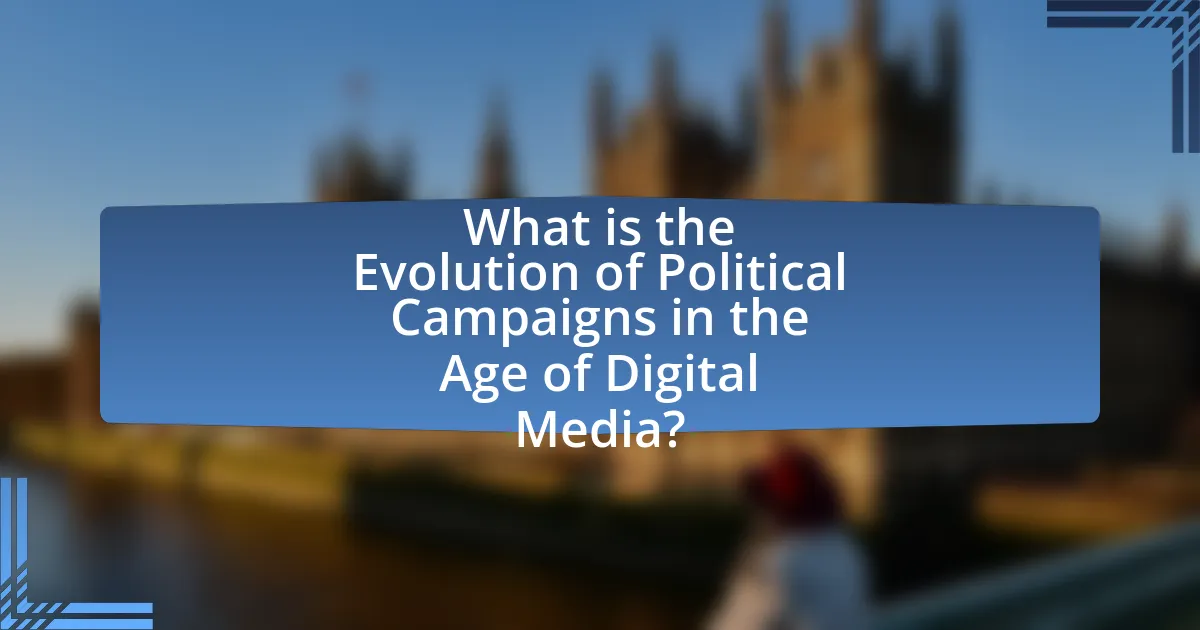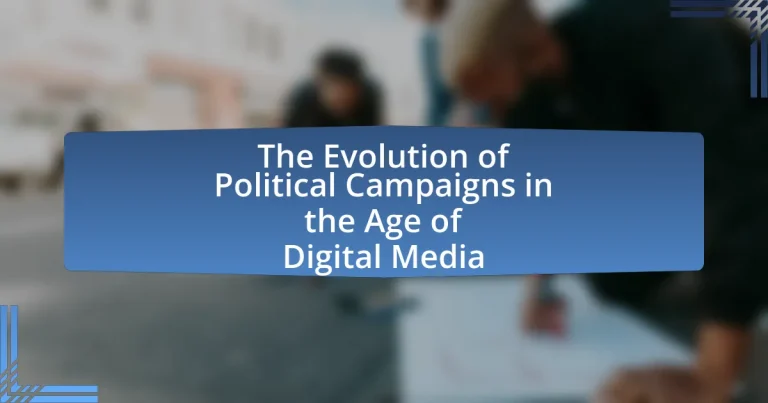The article examines the evolution of political campaigns in the age of digital media, highlighting the shift from traditional methods to online platforms. It discusses how digital media has transformed voter engagement through social media, targeted advertising, and data analytics, significantly enhancing communication between candidates and voters. Key differences between traditional and digital campaigns are outlined, along with the implications of digital media on voter behavior and campaign strategies. The article also addresses challenges such as misinformation and privacy concerns, emphasizing the importance of transparency and ethical practices in modern political campaigning.

What is the Evolution of Political Campaigns in the Age of Digital Media?
The evolution of political campaigns in the age of digital media has transformed how candidates engage with voters, utilizing platforms like social media, email, and targeted online advertising. Initially, political campaigns relied heavily on traditional media such as television and print; however, the rise of the internet in the late 1990s and early 2000s marked a significant shift. For instance, Barack Obama’s 2008 campaign effectively used social media to mobilize young voters, raising over $500 million online, which demonstrated the power of digital outreach. Furthermore, data analytics has become integral, allowing campaigns to tailor messages to specific demographics, as seen in the 2016 U.S. presidential election where micro-targeting strategies were employed extensively. This shift to digital media has not only increased voter engagement but also changed the dynamics of political communication, making it more immediate and interactive.
How has digital media transformed traditional political campaigning?
Digital media has transformed traditional political campaigning by enabling direct communication between candidates and voters, significantly enhancing engagement and outreach. This transformation is evident in the use of social media platforms, which allow campaigns to disseminate messages rapidly and interactively, reaching millions of potential voters instantly. For instance, during the 2008 U.S. presidential election, Barack Obama’s campaign effectively utilized social media to mobilize supporters, resulting in over 1.5 million followers on Facebook and a substantial increase in voter turnout among young demographics. Additionally, digital media facilitates targeted advertising through data analytics, allowing campaigns to tailor messages to specific voter segments, thereby increasing the efficiency of campaign strategies. The shift from traditional media to digital platforms has fundamentally changed how political messages are crafted, delivered, and received, making campaigns more dynamic and responsive to public sentiment.
What are the key differences between traditional and digital political campaigns?
Traditional political campaigns primarily rely on offline methods such as television, radio, print media, and in-person events, while digital political campaigns utilize online platforms, social media, and digital advertising. Traditional campaigns often have a broader reach but are less targeted, whereas digital campaigns allow for precise audience segmentation and real-time engagement. For instance, a study by the Pew Research Center in 2020 indicated that 69% of Americans use social media, highlighting the effectiveness of digital platforms in reaching voters. Additionally, digital campaigns can analyze data and adjust strategies quickly, unlike traditional campaigns that follow a more static approach.
How has voter engagement changed with the rise of digital media?
Voter engagement has significantly increased with the rise of digital media. Digital platforms enable real-time communication, allowing campaigns to reach a broader audience and engage voters through targeted messaging. For instance, a study by the Pew Research Center found that 69% of adults in the U.S. use social media, which has become a crucial tool for political outreach and mobilization. Additionally, data from the 2020 U.S. elections indicated that online engagement, such as sharing political content and participating in discussions, correlated with higher voter turnout, demonstrating the effectiveness of digital media in enhancing civic participation.
Why is understanding this evolution important for modern politics?
Understanding the evolution of political campaigns in the age of digital media is crucial for modern politics because it shapes how candidates engage with voters and influence public opinion. The transition from traditional media to digital platforms has transformed communication strategies, allowing for targeted messaging and real-time interaction. For instance, the 2008 Obama campaign effectively utilized social media to mobilize young voters, demonstrating the power of digital outreach. This shift highlights the necessity for political entities to adapt to changing technologies and voter behaviors to remain relevant and effective in their campaigns.
What implications does digital media have on voter behavior?
Digital media significantly influences voter behavior by shaping information access, engagement levels, and opinion formation. It allows voters to receive real-time updates and diverse viewpoints, which can lead to increased political awareness and participation. For instance, studies show that social media platforms have become primary sources of news for many voters, with 62% of Americans getting news from social media, according to the Pew Research Center. This shift alters traditional campaign strategies, as candidates must now engage with voters online to effectively communicate their messages and mobilize support. Additionally, digital media facilitates targeted advertising, enabling campaigns to reach specific demographics with tailored messages, which can sway voter preferences and turnout.
How do political candidates adapt to the digital landscape?
Political candidates adapt to the digital landscape by leveraging social media platforms, data analytics, and targeted advertising to engage voters effectively. For instance, candidates utilize platforms like Facebook and Twitter to communicate directly with constituents, share campaign messages, and respond to public concerns in real-time. Data analytics allows candidates to analyze voter behavior and preferences, enabling them to tailor their messages and outreach strategies. A notable example is the 2008 Obama campaign, which effectively used social media and data-driven strategies to mobilize young voters, resulting in a significant increase in voter turnout among that demographic.

What are the major milestones in the evolution of political campaigns?
The major milestones in the evolution of political campaigns include the establishment of the first organized political parties in the early 19th century, the introduction of mass media in the 20th century, and the rise of digital media in the 21st century. The formation of political parties, such as the Democratic and Republican parties in the United States, marked the beginning of structured campaigning. The advent of radio and television transformed campaigns by enabling candidates to reach a broader audience, exemplified by John F. Kennedy’s televised debates in 1960, which significantly impacted public perception. The emergence of the internet and social media platforms, particularly in the 2008 Obama campaign, revolutionized voter engagement and targeted advertising, allowing for real-time interaction and data-driven strategies. These milestones illustrate the continuous adaptation of political campaigns to technological advancements and changing voter behaviors.
How did the internet change the landscape of political communication?
The internet transformed political communication by enabling direct interaction between politicians and the electorate, bypassing traditional media gatekeepers. This shift allowed for real-time dissemination of information, fostering greater engagement through social media platforms, which became essential tools for campaigns. For instance, during the 2008 U.S. presidential election, Barack Obama’s campaign effectively utilized social media to mobilize supporters and raise funds, demonstrating the internet’s capacity to influence voter behavior and campaign strategies. Additionally, the internet facilitated the spread of diverse viewpoints and grassroots movements, exemplified by the rise of platforms like Change.org, which empowered citizens to advocate for political change directly.
What role did social media play in recent political campaigns?
Social media has played a crucial role in recent political campaigns by serving as a primary platform for communication, engagement, and mobilization of voters. Campaigns utilize social media to disseminate information rapidly, allowing candidates to reach large audiences directly and interactively. For instance, during the 2020 U.S. presidential election, candidates like Joe Biden and Donald Trump leveraged platforms such as Twitter and Facebook to share their messages, respond to public concerns, and rally support, resulting in millions of followers and extensive engagement metrics. According to a Pew Research Center study, 69% of Americans reported using social media for political news, highlighting its significance in shaping public opinion and influencing voter behavior.
How have data analytics influenced campaign strategies?
Data analytics have significantly influenced campaign strategies by enabling targeted messaging and optimizing resource allocation. Campaigns now utilize data to analyze voter behavior, preferences, and demographics, allowing for personalized communication that resonates with specific audiences. For instance, the 2012 Obama campaign famously used data analytics to identify and mobilize key voter segments, resulting in a 5% increase in voter turnout compared to previous elections. This data-driven approach has become essential, as campaigns can now measure the effectiveness of their strategies in real-time, adjusting tactics based on performance metrics.
What technological advancements have shaped political campaigning?
Technological advancements that have shaped political campaigning include social media platforms, data analytics, and mobile technology. Social media platforms like Facebook and Twitter have revolutionized how candidates communicate with voters, allowing for real-time engagement and targeted messaging. Data analytics enables campaigns to analyze voter behavior and preferences, facilitating more effective outreach strategies. Mobile technology has increased accessibility to campaign information and engagement through apps and text messaging, enhancing voter mobilization efforts. These advancements have fundamentally transformed the landscape of political campaigning, making it more interactive and data-driven.
How do mobile applications impact voter outreach?
Mobile applications significantly enhance voter outreach by providing direct communication channels between campaigns and voters. These applications facilitate real-time engagement, allowing campaigns to disseminate information, mobilize supporters, and encourage voter participation efficiently. For instance, a study by the Pew Research Center found that 45% of Americans reported using their smartphones to access political information, indicating a strong reliance on mobile technology for political engagement. Additionally, mobile apps can target specific demographics through personalized messaging, increasing the likelihood of voter turnout. This targeted approach is supported by data showing that campaigns utilizing mobile outreach strategies saw a 20% increase in voter engagement compared to traditional methods.
What is the significance of online fundraising in modern campaigns?
Online fundraising is significant in modern campaigns as it enables candidates to reach a broader audience and secure financial support quickly and efficiently. This method allows for real-time engagement with potential donors, facilitating contributions from individuals who may not have been accessible through traditional fundraising methods. According to a report by the Pew Research Center, 69% of Americans have made online donations, highlighting the growing reliance on digital platforms for fundraising efforts. Additionally, online fundraising can reduce costs associated with traditional fundraising events, allowing campaigns to allocate resources more effectively.

What challenges do political campaigns face in the digital age?
Political campaigns face several challenges in the digital age, including misinformation, data privacy concerns, and the rapid pace of technological change. Misinformation can spread quickly on social media platforms, undermining the credibility of campaigns and confusing voters. Data privacy concerns arise as campaigns collect and utilize vast amounts of personal information, leading to potential breaches of trust and regulatory scrutiny. Additionally, the rapid evolution of technology requires campaigns to continuously adapt their strategies, which can strain resources and expertise. These challenges necessitate a proactive approach to ensure effective communication and voter engagement.
How do misinformation and fake news affect political campaigns?
Misinformation and fake news significantly undermine political campaigns by distorting public perception and influencing voter behavior. Research indicates that exposure to false information can lead to decreased trust in candidates and institutions, as evidenced by a study from the Pew Research Center, which found that 64% of Americans believe fabricated news stories cause confusion about basic facts. Additionally, misinformation can create polarization among voters, as individuals are more likely to share content that aligns with their pre-existing beliefs, further entrenching divisions. The 2016 U.S. presidential election exemplified this, where false narratives circulated widely on social media, impacting voter opinions and potentially swaying election outcomes.
What strategies can campaigns employ to combat misinformation?
Campaigns can employ fact-checking, media literacy initiatives, and transparent communication to combat misinformation. Fact-checking involves verifying claims made in political discourse and publicly correcting false information, which has been shown to reduce the spread of misinformation by up to 70% in some studies. Media literacy initiatives educate the public on identifying credible sources and understanding media biases, fostering critical thinking skills that empower individuals to discern misinformation. Transparent communication from campaigns, including open dialogue and timely responses to false claims, builds trust and encourages voters to seek accurate information directly from reliable sources. These strategies collectively enhance the integrity of political discourse in the digital age.
How does the digital divide impact campaign effectiveness?
The digital divide significantly impacts campaign effectiveness by limiting access to information and engagement opportunities for certain demographics. Campaigns that rely heavily on digital platforms may fail to reach individuals without reliable internet access or digital literacy, resulting in skewed outreach and engagement. For instance, a report by the Pew Research Center indicates that approximately 25% of adults in rural areas lack broadband internet, which can hinder their participation in online campaign activities. Consequently, this divide can lead to unequal representation and influence in political processes, ultimately affecting the overall success of campaigns.
What ethical considerations arise in digital political campaigning?
Ethical considerations in digital political campaigning include issues of misinformation, data privacy, and manipulation of voter behavior. Misinformation can spread rapidly through social media, leading to the distortion of facts and influencing public opinion based on false narratives. Data privacy concerns arise when campaigns collect and utilize personal information without consent, potentially violating individuals’ rights. Additionally, the use of targeted advertising can manipulate voter behavior by exploiting psychological insights, raising questions about the fairness and transparency of the electoral process. These considerations highlight the need for ethical guidelines to govern digital campaigning practices.
How do privacy concerns influence voter trust in campaigns?
Privacy concerns significantly diminish voter trust in campaigns. When voters perceive that their personal data is being collected, used, or shared without their consent, they often feel vulnerable and skeptical about the intentions of political campaigns. For instance, a 2020 survey by the Pew Research Center found that 79% of Americans expressed concern about how their data is collected and used by companies, including political entities. This distrust can lead to disengagement from the electoral process, as voters may question the authenticity and integrity of campaign messages. Furthermore, incidents like the Cambridge Analytica scandal, where personal data was misused for targeted political advertising, have heightened awareness and anxiety around privacy issues, further eroding trust in campaigns.
What regulations exist to govern digital political advertising?
Regulations governing digital political advertising include the Federal Election Commission (FEC) rules in the United States, which require disclosure of the source of funding for political ads and mandate that advertisements include a disclaimer stating who paid for them. Additionally, the Honest Ads Act proposes to extend these requirements to online platforms, ensuring transparency in political advertising similar to traditional media. The European Union’s General Data Protection Regulation (GDPR) also impacts digital political advertising by enforcing strict data privacy standards that affect how political campaigns can target voters online. These regulations aim to enhance transparency and accountability in political advertising, addressing concerns about misinformation and foreign interference in elections.
What best practices should modern political campaigns adopt?
Modern political campaigns should adopt data-driven strategies, leveraging analytics to target voters effectively. By utilizing voter data and behavioral insights, campaigns can tailor their messages to resonate with specific demographics, increasing engagement and support. For instance, a study by the Pew Research Center found that campaigns using targeted digital advertising saw a 20% increase in voter turnout compared to those relying on traditional methods. Additionally, integrating social media platforms for real-time communication allows campaigns to respond swiftly to public sentiment, enhancing their relevance and connection with constituents.
How can campaigns effectively utilize social media for engagement?
Campaigns can effectively utilize social media for engagement by creating targeted content that resonates with specific audience segments. This approach allows campaigns to foster meaningful interactions, as evidenced by a study from the Pew Research Center, which found that 69% of adults in the U.S. use social media, making it a vital platform for reaching voters. By leveraging data analytics, campaigns can tailor their messaging and timing to align with audience preferences, enhancing engagement rates. Additionally, interactive elements such as polls, live Q&A sessions, and user-generated content can further increase participation and investment from followers, leading to a more engaged electorate.
What role does transparency play in building voter trust?
Transparency is crucial in building voter trust as it fosters accountability and openness in the electoral process. When political campaigns provide clear information about their policies, funding sources, and decision-making processes, voters are more likely to feel informed and engaged. Research indicates that 70% of voters are more likely to trust candidates who openly share their campaign strategies and financial backers. This level of transparency reduces the perception of corruption and misinformation, which are significant barriers to trust. Therefore, transparency not only enhances the credibility of political campaigns but also strengthens the democratic process by encouraging informed voter participation.


